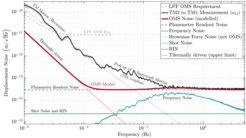The first sub-picometer laser interferometer in space
Analysing the in-flight performance of LISA Pathfinder's optical metrology system
LISA Pathfinder (LPF) was an ESA test mission for LISA, the planned space-based gravitational-wave observatory. LPF successfully demonstrated key LISA technologies and exceeded expectations by far. An international team with several members from AEI Hannover has now published a first detailed analysis of the exceptional performance of the LPF Optical Metrology System (OMS). It performed the fundamental measurement of the motion of two free-falling cubic test masses and was the first laser interferometer with sub-picometer resolution in space. The team investigated the noise behaviour and its constituents in detail and developed and validated a system noise model. The interferometer performed stably and consistently much better than its requirement. This is a key milestone towards the construction of the more complex optical system to be used in LISA.
Paper abstract
We report on the first sub-picometer interferometer flown in space. It was part of ESA’s LISA Pathfinder mission and performed the fundamental measurement of the positional and angular motion of two free-falling test masses. The interferometer worked immediately, stably and reliably from switch-on until the end of the mission with exceptionally low residual noise of 32.0+2.4−1.7 fm/√Hz, significantly better than required. We present an upper limit for the sensor performance at mHz frequencies and a model for the measured sensitivity above 200 mHz.













